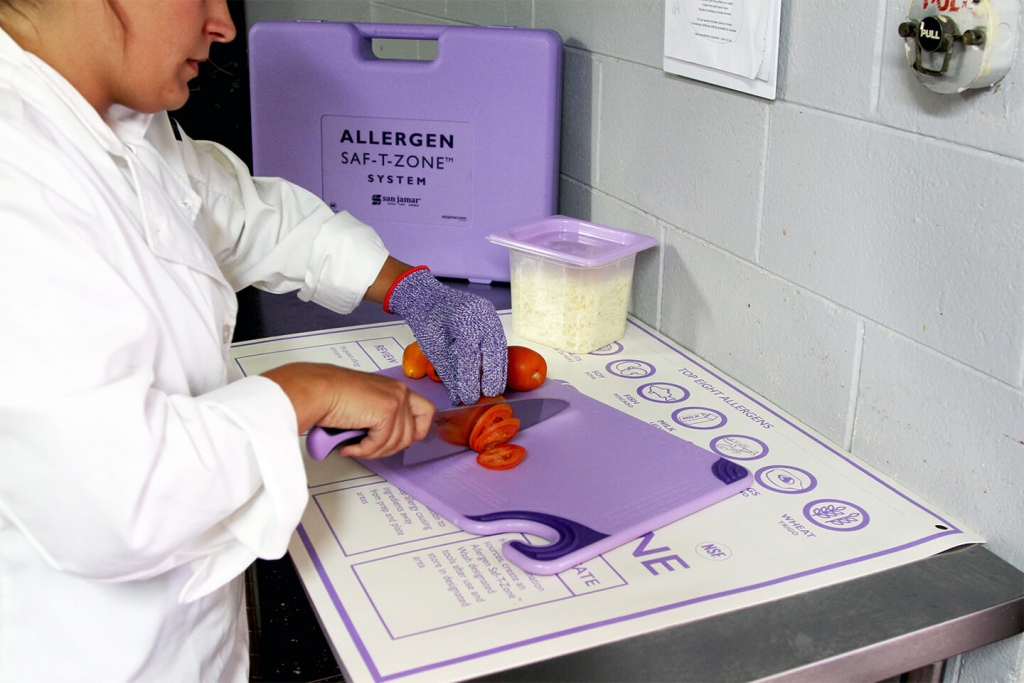Updated 1-19-23: Sesame became the 9th official allergen listed in the United States in 2021. As of January 2023, food labels are now required to clearly list sesame as an allergen.
Until this time, sesame was allowed to be listed as a “natural flavor” or “spice mix.” Products already in stock or shipped prior to 2023 will not list sesame as an allergen, so those affected should take precaution during this transition period.
———————————————
As of 2021, an estimated 1 in 10 adults and 1 in 13 children in the United States have been diagnosed with food allergies. Moreover, prevalence is steadily rising, and this once unfamiliar public health issue has grown into an epidemic.

What Is a Food Allergy?
Food Allergy Research & Education (FARE) defines a food allergy as “a medical condition in which exposure to a food triggers a harmful immune response.” The smallest bit of exposure to the trigger food can cause customers to experience:
- Breathing difficulties;
- Swelling of the throat and lips;
- Cramping and digestive distress and;
- Anaphylactic shock which is a sudden reaction that can lead to death.
The most common ingredients that can trigger an allergic reaction are milk, eggs, peanuts, soy, wheat, tree nuts, fish (shellfish and finned) and sesame.

What Causes Food Allergies?
The number of people diagnosed with food allergies as well as the number of foods people experience allergic reactions to continues to rise. Although scientists haven’t definitively pinpointed why food allergies have experienced a significant increase throughout the Western population, researchers have been busy analyzing several theories including:
- Pollution: Studies conducted by the Canadian Healthy Infant Longitudinal Development (CHILD) group linked exposure to traffic-related air pollution within the first year of life to a higher probability of developing food allergies.
- Gut Microbiota: Researchers from the CHILD group also theorize reduced exposure to microbes weaken the immune system, and gut bacteria composition may play a role in food allergy development.
- Vitamin D: Scientists also theorize low vitamin D exposure plays a role in the occurrence of food allergies.
A Message for the Restaurant Industry
We surveyed several online allergy communities and asked them about their struggles with eating in restaurants. Several themes quickly emerged from participant comments. Here is an overview of what your guests wished restaurants knew about food allergies.
Real People, Real Consequences
“I want restaurants to know how serious it is. They won’t just get a belly ache. They can die if the staff doesn’t communicate effectively.”
“My daughter used to be contact anaphylaxis so we would never take her to restaurants. People who don’t have allergies don’t seem to understand how severe they can be. Also, epi pens don’t necessarily work every time.”
“The waitstaff needs to take someone seriously when they say they have an allergy. I told a server multiple times that I have a dairy allergy, so she got me the allergen menu. I then ordered strictly steamed broccoli and it came with gravy on it. It is maddening.”
Of the estimated 32 million food allergy sufferers in the United States, approximately 200,000 people require emergency assistance each year. The two most common places a person is likely to experience an allergic reaction is in the home and at a restaurant. If anaphylaxis starts, the only effective treatment is an immediate injection of epinephrine, which, as one respondent pointed out, may not always work or may require more than one dose.

Food Allergies vs. Intolerances
Between today’s myriad fad diets, food intolerances, and food lifestyles, it may be confusing for some staff to distinguish between those with a medical food allergy and those with a food preference or sensitivity. Lactose intolerance, for example, is a digestive disorder that isn’t pleasant to experience but unlike a food allergy, it will not kill you. Lactose intolerant people, as opposed to those with a dairy allergy, will not have a reaction from trace amounts of dairy protein and ingesting dairy doesn’t affect their immune system.
Know Your Ingredients
“Know and/or list ingredients in each dish. It may be time consuming at first, but well worth it. I’ve recently had three restaurants tell me they didn’t know if their chicken breading contained egg. I think they should be required to know the ingredients in the food.”

As more people develop food allergies, it may also help restaurants stay competitive if they take the time and energy to educate restaurant staff in, for instance, which foods trigger a dairy allergy. For example, one surveyed respondent stated, “There is no excuse for restaurant staff not knowing that butter is milk.”
Having a readily available ingredient list for customers shows that you take pride in your work and are knowledgeable in what you serve to guests. When word gets around that your restaurant goes the extra mile to take care of your customers, it can generate additional repeat business. It’s a win-win for everyone.
Dietary Restrictions for Restaurants »
Understand Cross Contact
“Restaurants should be required to have allergy and food safety training. A regular person doesn’t know that a spatula used to flip an egg on a buttered grill could quite literally end my life. It is not as simple as checking the ingredients.”
“Skip garnishes and pre-made items for anyone with allergies because there is no way to verify it was handled safety, without cross contact. Removing an ingredient off a plate is not safe. They have to start over if there is a mistake.”
Cross contact is when food touches surfaces, utensils, or equipment that carry even the smallest traces of the allergen. Cross contamination is one factor that can lead to foodborne illness from bacteria and viruses due to improper preparation and storage temperature.

These two terms are often mistakenly used interchangeably but are entirely different in practice. The kitchen staff should receive appropriate training to avoid not only the ingredients the customer is allergic to, but also to avoid cross contact with that ingredient.
Inclusiveness and Accommodation
Researchers at Oxford University found that, “people who eat socially are more likely to feel better about themselves and have a wider social network capable of providing social and emotional support.” It comes as no surprise that most people love to eat out at restaurants with friends or family, including those with life threatening food allergies.

Those surveyed echoed this sentiment in the following statements:
“Patrons who bring in outside food are doing so because the restaurant’s food simply isn’t safe for them to eat, but they want to be able to eat out with family and friends.”
“List that you accommodate allergens on your website. If you have menu items that are easier to adapt to accommodate allergies, highlight those.”
“It really makes our hearts overflow with joy when we find a restaurant that’s so accommodating and knowledgeable where we can feel Safe.”
Attention to Detail
“Items that stay at the table such as ketchup, don’t refill those bottles with a different brand than is what is on the label.”
“An allergen plate should be a different color.”

Restaurant management of food allergies includes the big picture and the smallest of details. Managing easy-to-overlook details are necessary to avoid allergic reactions. Safeguards held in place can mean the difference between life and death, especially for a long-time patrons who had safely ordered the same dish many times in the past.
Legal Requirements
“As an allergy advocate, I can say that the issue of food allergy management in food service establishments should not be something that requires legislation to make sure it happens.”
Currently, only five US states are legally required to provide allergy training for restaurant staff; Massachusetts, the first to enact a law in 2011, Maryland, Michigan, Rhode Island, and Virginia. It is up to the remaining states to take the initiative to make their foodservice establishments allergy-safe to avoid legislation.
Establish Strict Protocols and Action Plans
Creating strong standard operating procedures (SOPs) paired with mindful training can go a long way in keeping your customers safe. A restaurant owner may want to have a trained staff member for each shift who can confidently handle food orders from customers with food allergies. Everyone from the prep cook, to the waitstaff, to the bussers should be involved in allergy training. Successfully managing food allergies is most effective as a team effort.
“Have someone trained to talk to people with allergies- a manager, a chef, or someone, who is knowledgeable about allergies. Do not take offense if a server is asked to talk to a manager or someone else about the order.”
“Have an allergy protocol and strict adherence. I once ordered a hamburger and it came out as a cheeseburger – My daughter is allergic to dairy. My heart sank and my anxiety levels spiked. And this restaurant had an allergy menu and protocols!”
“My stepdad is a cook and we had to throw out a batch of soup because he used a spatula from earlier that morning. The only reason there wasn’t in incident is because my mom watched him the whole time! There should be someone to supervise and make sure stuff like this doesn’t happen in restaurants.”
Read Up On Milk Substitutes »
Where to Begin
One major stressor people with food allergies face in restaurants is not knowing whether servers clearly understand their needs and are able to effectively communicate them to the kitchen.

Current CDC recommendations to help prevent allergic reactions are as follows:
- Provide food allergy training to restaurant staff.
- Use dedicated equipment, utensils, storage, and surface areas for preparing and cooking meals for customers with food allergies. If this is not feasible, equipment and workspaces must be cleaned before preparing a meal for a customer with allergies. Restaurants can refer to the FDA’s food code guidelines for more information.
- Have ingredient lists and recipes available for menu items.
CDC recommendations are a wonderful place to start to make your establishment safe and inclusive to our ever-growing population of food allergy sufferers.




Great Article, and would like to use it fortraining, but it will not print?
There is a “Print” icon at the top of the article just below the header image. Did you try that?